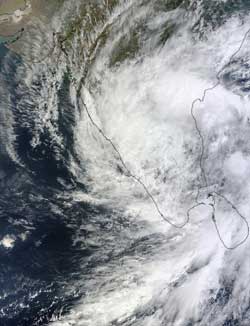NASA sees Tropical Depression Nilam blanket southern India

The MODIS instrument that flies aboard NASA's Terra satellite captured this visible image of Tropical Cyclone Nilam over southern India on Nov. 1 at 05:50 UTC (1:50 a.m. EDT).<br><br>Credit: NASA Goddard MODIS Rapid Response Team<br>
On Nov. 1 at 05:50 UTC (1:50 a.m. EDT), the Moderate Resolution Imaging Spectroradiometer (MODIS) instrument that flies aboard NASA's Terra satellite captured a visible image of Tropical Depression Nilam.
The MODIS image showed that Nilam's clouds stretched as far north as Andra Pradesh, a state in east central India. It covered the states of Goa and Karnataka in the west, all the way down to the states of Tamil Nadu, Puducherry and Kerala in extreme southern India.
On Oct. 31 at 1500 UTC (11 a.m. EDT/8:30 p.m. local time, India), Nilam made landfall over southeastern India and started to elongate. When a system is no longer circular and starts to elongate, it begins to weaken.
India's Regional Specialised Meteorological Centre (RSMC) issued a bulletin on Tropical Depression Nilam on Nov. 1 at 2 a.m. EDT (11:30 a.m. local time/India). At that time, Nilam was centered over Rayalaseema. Rayalaseema is a geographic region in the state of Andhra Pradesh. The RSMC noted that Nilam is expected to move northwestward and weaken to a remnant low pressure area later on Nov. 1.
The RSMC expects heavy rainfall over Rayalaseema, Karnataka and south coastal Andhra Pradesh and north Tamilnadu on Nov. 1 and Nov. 2 before the storm dissipates.
Media Contact
More Information:
http://www.nasa.govAll latest news from the category: Earth Sciences
Earth Sciences (also referred to as Geosciences), which deals with basic issues surrounding our planet, plays a vital role in the area of energy and raw materials supply.
Earth Sciences comprises subjects such as geology, geography, geological informatics, paleontology, mineralogy, petrography, crystallography, geophysics, geodesy, glaciology, cartography, photogrammetry, meteorology and seismology, early-warning systems, earthquake research and polar research.
Newest articles

High-energy-density aqueous battery based on halogen multi-electron transfer
Traditional non-aqueous lithium-ion batteries have a high energy density, but their safety is compromised due to the flammable organic electrolytes they utilize. Aqueous batteries use water as the solvent for…

First-ever combined heart pump and pig kidney transplant
…gives new hope to patient with terminal illness. Surgeons at NYU Langone Health performed the first-ever combined mechanical heart pump and gene-edited pig kidney transplant surgery in a 54-year-old woman…

Biophysics: Testing how well biomarkers work
LMU researchers have developed a method to determine how reliably target proteins can be labeled using super-resolution fluorescence microscopy. Modern microscopy techniques make it possible to examine the inner workings…





















